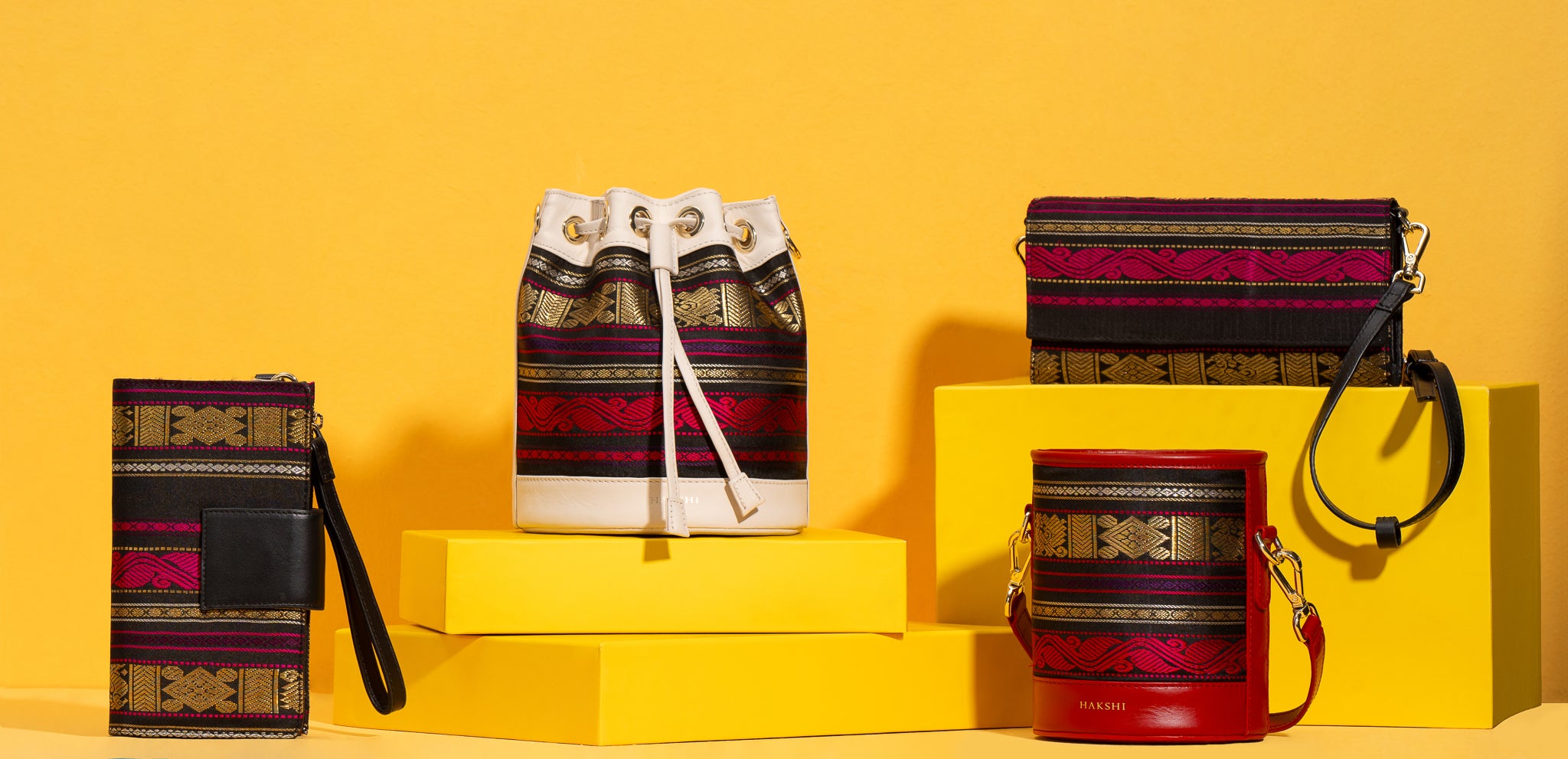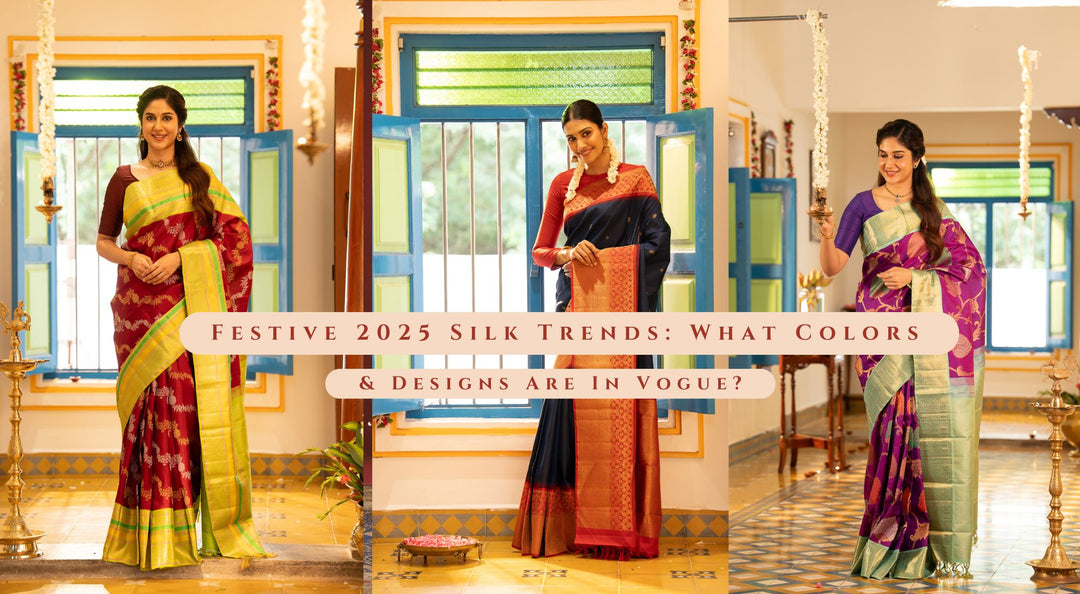What is the Difference Between Korvai, Petni, and Benth Technique in Kanjivaram Silk?
Kanjivaram the name itself evokes images of timeless beauty, heritage, and unmatched craftsmanship. Among the many weaving traditions of India, pure Kanjivaram silk sarees hold a distinct place for their rich texture, lustrous finish, and intricately woven zari borders. But what truly makes these sarees extraordinary are the unique weaving techniques that define their character Korvai, Petni, and Benth (or Benku).
Each of these techniques tells a story of artistry, precision, and generations of skill that have made the Kanchipuram silk saree world-famous. In this blog, let’s explore what sets these weaving methods apart and why they are integral to the beauty of Kanjivaram silk.
The Heritage of Kanjivaram Weaving
The town of Kanchipuram in Tamil Nadu has been the epicenter of silk weaving for centuries. Often called the “City of Silk,” it is home to master weavers who transform threads of pure mulberry silk into works of art. Every Kanchipuram saree silk is known for its durability, richness, and deep cultural significance often becoming heirlooms passed down through generations.
What makes a pure Kanchipuram silk saree stand out is not just its material or zari but the complex weaving techniques used in its making. Let’s take a closer look at the three iconic methods Korvai, Petni, and Benth that make each saree unique.

1. Korvai Technique: The Bold Contrast Beauty
What is Korvai?
The word Korvai literally means “to join.” In weaving terms, it refers to the traditional technique where the body of the saree and the border are woven separately and joined on the loom using a precise interlocking method.
This is the reason behind the distinct color contrast you often see in a pure Kanjivaram silk saree for example, a rich red body with a bright green or gold border.
How It Works
-
The weaver prepares two sets of silk threads one for the body and another for the border.
-
Using an interlocking method, these two are skillfully joined while weaving on the loom.
-
The joining process has to be so precise that there are no visible stitches or gaps.
-
It usually requires two or three weavers working in perfect synchronization.
Signature Look
-
Sharp and strong color contrast between the saree’s body and border.
-
The join line is smooth, not stitched or printed.
-
The borders are often thick, bold, and heavily decorated with zari.
Why It’s Special
The Korvai technique is a hallmark of traditional Kanchipuram silks.
It’s labor-intensive and time-consuming, which is why Korvai Kanjivarams are usually priced higher. The technique showcases not only the weaver’s mastery but also the aesthetic power of color contrast, a symbol of the cultural richness of Tamil Nadu.
Example
A deep maroon saree with a contrasting emerald green zari border is a classic Korvai masterpiece perfect for weddings and grand celebrations.

Explore traditional Kanchipuram Kanjivaram silks sarees handcrafted with Korvai borders.
2. Petni Technique: The Graceful Color Merge
What is Petni?
Petni (or Pitni) refers to the technique where the pallu (anchal) of the saree is woven separately and then attached to the main body.
Unlike the Korvai, where the joint is sharp and contrasting, the Petni creates a soft gradient transition between the body and the pallu.
How It Works
-
The pallu is designed with a different color scheme or zari pattern.
-
During weaving, the pallu is joined to the body using a color-merge technique known as rekku petni.
-
The join appears as a smooth, blended gradient, not an abrupt line.
Signature Look
-
A contrasting pallu that looks naturally merged with the saree body.
-
The transition of color appears smooth and elegant.
-
The pallu often has rich zari work and intricate motifs.
Why It’s Special
The Petni technique adds a touch of grace and sophistication to pure Kanchipuram silk sarees. It creates a harmonious blend between boldness and subtlety perfect for those who prefer elegance with artistic detailing.
This technique requires patience and precision, making Petni sarees moderately high in cost, depending on the intricacy of the pallu design.
Example
Imagine a golden-yellow saree gradually blending into a magenta pallu that’s the magic of Petni weaving, offering both richness and charm in one drape.

Discover more elegant wedding Kanchipuram silks beautifully crafted with Petni pallus.
3. Benth (Benku) Technique: The Architectural Precision
What is Benth?
The Benth or Benku technique is a weaving method used to create large motifs, temple borders, or checks (kattam) that cannot be woven in a single pass.
In this method, the warp or weft threads are turned or “bent” during weaving to form geometric shapes such as steps, triangles, or rectangles resembling temple architecture.
How It Works
-
The weaver manipulates the yarns by turning them back and forth in certain sections.
-
This bending helps form complex motifs like gopuram (temple tower) designs or large checks.
-
The technique is often used in sarees featuring traditional temple borders.
Signature Look
-
Borders or motifs have step-like, geometric shapes.
-
The designs appear sharp and structured, never printed or embroidered.
-
Often combined with zari to enhance definition and shine.
Why It’s Special
The Benth technique brings an architectural quality to Kanjivaram silk sarees, reflecting the heritage of South Indian temple art. It is moderately complex and valued for the precision it brings to motifs, a true example of artistry meeting geometry.
Example
A rich purple saree with gold temple step borders (Gopuram design) crafted using the Benth technique is a true expression of Tamil heritage and sacred symbolism.

Shop timeless pure Kanchipuram silk sarees that celebrate the elegance of traditional weaving craftsmanship.
Quick Comparison Table
|
Feature |
Korvai |
Petni |
Benth / Benku |
|
What is Joined? |
Body + Border |
Body + Pallu |
Motif Borders / Patterns |
|
Color Contrast |
Very strong |
Smooth transition |
Depends on design |
|
Look & Feel |
Bold borders |
Rich, elegant pallu |
Sharp, stepped motifs |
|
Difficulty |
High |
Medium–High |
Medium |
|
Cost |
Usually Highest |
Medium to High |
Medium |
|
Traditional Value |
Very High |
High |
Moderate to High |

In Short
-
Korvai – A traditional technique joining the body and border with bold contrast.
-
Petni – A smooth blending of pallu and body using color merge.
-
Benth – A pattern-weaving method for temple borders, checks, and geometric motifs.
Each of these techniques adds its unique charm to a pure Kanjivaram silk saree, reflecting the artistic legacy of Kanchipuram. Whether it’s the bold contrasts of Korvai, the graceful blending of Petni, or the architectural detailing of Benth every weave speaks of the weaver’s devotion and skill.
Why These Techniques Matter
Understanding these weaving techniques helps you appreciate the value and authenticity of every Kanjivaram silk saree you buy. It’s not just fabric it’s a legacy woven with passion, patience, and precision.
When you choose an authentic Kanchipuram silk saree, you’re not just wearing a piece of luxury; you’re draping centuries of Indian heritage.

Explore Authentic Kanjivaram Silks
At Clio Silks, we bring you an exquisite collection of pure Kanchipuram silk sarees that celebrate these traditional weaving styles from vibrant Korvai borders to elegant Petni pallus and intricate Benth motifs.






Leave a comment